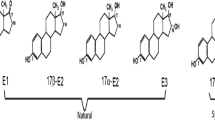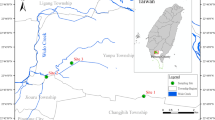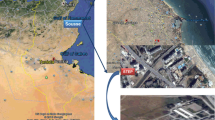Abstract
An efficient pretreatment and analytical method was developed to investigate the occurrence and fate of four free estrogens (estrone (E1), 17β-estradiol (17β-E2), estriol (E3), and 17α-ethinylestradiol (EE2)), four conjugated estrogens (estrone-3-sulfate sodium salt (E1-3S), 17β-estradiol-3-sulfate sodium salt (E2-3S), estrone-3-glucuronide sodium salt (E1-3G), and 17β-estradiol-3-glucuronide sodium salt (E2-3G)), and bisphenol A (BPA) in three livestock farms raising beef cattle, cows, sheep, swine, and chickens in Qi County, which is located in North China. The results demonstrated that one cow and one beef cattle excreted 956.25–1,270.41 and 244.38–319.99 μg/day of total (free and conjugated) estrogen, respectively, primarily through feces (greater than 91 %), while swine excreted 260.09–289.99 μg/day of estrogens, primarily through urine (98–99 %). The total estrogen excreted in sheep and broiler chicken feces was calculated to be 21.64–28.67 and 4.62–5.40 μg/day, respectively. It was determined that conjugated estrogens contributed to 21.1–21.9 % of the total estrogen excreted in cow feces and more than 98 % of the total estrogen excreted in swine urine. After composting, the concentration of total estrogen decreased by 18.7–59.6 %; however, increased levels of BPA were measured. In treated compost samples, estrogens were detected at concentrations up to 74.0 ng/g, which indicates a potential risk of estrogens entering the surrounding environment.


Similar content being viewed by others

References
Bartelt-Hunt S, Snow DD, Damon-Powell T, Miesbach D (2011) Occurrence of steroid hormones and antibiotics in shallow groundwater impacted by livestock waste control facilities. J Contam Hydrol 123:94–103
Belfroid AC, Van der Horst A, Vethaak AD, Sch A, Fer AJ, Rijs G, Wegener J, Cofino WP (1999) Analysis and occurrence of estrogenic hormones and their glucuronides in surface water and waste water in The Netherlands. Sci Total Environ 225:101–108
Cao J, Shi J, Han R, Li Y, Yang Z (2010) Seasonal variations in the occurrence and distribution of estrogens and pharmaceuticals in the Zhangweinanyun river system. Chin Sci Bull 55:3138–3144
Chen Q, Shi J, Wu W, Liu X, Zhang H (2012) A new pretreatment and improved method for determination of selected estrogens in high matrix solid sewage samples by liquid chromatography mass spectrometry. Microchem J 104:49–55
Chen T, Chen T, Yeh KJC, Chao H, Liaw E, Hsieh CY, Chen K, Hsieh LT, Yeh YL (2010) High estrogen concentrations in receiving river discharge from a concentrated livestock feedlot. Sci Total Environ 408:3223–3230
Coleman HM, Routledge EJ, Sumpter JP, Eggins BR, Byrne JA (2004) Rapid loss of estrogenicity of steroid estrogens by UVA photolysis and photocatalysis over an immobilised titanium dioxide catalyst. Water Res 38:3233–3240
Combalbert S, Hernandez-Raquet G (2010) Occurrence, fate, and biodegradation of estrogens in sewage and manure. Appl Microbiol Biot 86:1671–1692
Combalbert S, Pype M, Bernet N, Hernandez-Raquet G (2010) Enhanced methods for conditioning, storage, and extraction of liquid and solid samples of manure for determination of steroid hormones by solid-phase extraction and gas chromatography-mass spectrometry. Anal Bioanal Chem 398:973–984
Combalbert S, Bellet V, Dabert P, Bernet N, Balaguer P, Hernandez-Raquet G (2011) Fate of steroid hormones and endocrine activities in swine manure disposal and treatment facilities. Water Res 46:895–906
D'Ascenzo G, Di Corcia A, Gentili A, Mancini R, Mastropasqua R, Nazzari M, Samperi R (2003) Fate of natural estrogen conjugates in municipal sewage transport and treatment facilities. Sci Total Environ 302:199–209
Durant AA, Fente CA, Franco CM, Vázquez BI, Cepeda A (2002) Gas chromatography-tandem mass spectrometry determination of 17α-ethinylestradiol residue in the hair of cattle. Application to treated animals. J Agr Food Chem 50:436–440
Dutta S, Inamdar S, Tso J, Aga DS, Sims JT (2010) Free and conjugated estrogen exports in surface-runoff from poultry litter-amended soil. J Environ Qual 39:1688–1698
Dutta S, Inamdar S, Tso J, Aga DS (2012) Concentrations of free and conjugated estrogens at different landscape positions in an agricultural watershed receiving poultry litter. Water Air Soil Poll 225:2821–2836
El Kader NA, Robin P, Paillat JM, Leterme P (2007) Turning, compacting and the addition of water as factors affecting gaseous emissions in farm manure composting. Bioresour Technol 98:2619–2628
Fromme H, Küchler T, Otto T, Pilz K, Müller J, Wenzel A (2002) Occurrence of phthalates and bisphenol A and F in the environment. Water Resour 36:1429–1438
Hanselman TA, Graetz DA, Wilkie AC (2003) Manure-borne estrogens as potential environmental contaminants: a review. Environ Sci Technol 37:5471–5478
Hutchins SR, White MV, Hudson FM, Fine DD (2007) Analysis of lagoon samples from different concentrated animal feeding operations for estrogens and estrogen conjugates. Environ Sci Technol 41:738–744
Johnson AC, Williams RJ, Matthiessen P (2006) The potential steroid hormone contribution of farm animals to freshwaters, the United Kingdom as a case study. Sci Total Environ 362:166–178
Kumar V, Nakada N, Yasojima M, Yamashita N, Johnson AC, Tanaka H (2011) The arrival and discharge of conjugated estrogens from a range of different sewage treatment plants in the UK. Chemosphere 82:1124–1128
Lange IG, Daxenberger A, Schiffer B, Witters H, Ibarreta D, Meyer HHD (2002) Sex hormones originating from different livestock production systems: fate and potential disrupting activity in the environment. Analytica Chimica Acta 473:27–37
Le TAH, Clemens J, Nguyen TH (2012) Performance of different composting techniques in reducing oestrogens content in manure from livestock in a Vietnamese setting. Environ Monit Assess 185:415–423
Liu S, Ying G, Zhang R, Zhou L, Lai H, Chen Z (2012) Fate and occurrence of steroids in swine and dairy cattle farms with different farming scales and wastes disposal systems. Environ Pollut 170:190–201
MEPC (Ministry of Environmental Protection of the People’s Republic of China) (2001) Discharge standard of pollutants for livestock and poultry breeding, Beijing (in Chinese)
MOA (The Ministry of Agriculture of the People’s Republic of China) (2013) Approved feed additives (2013). Ministry of Agriculture the People’s Republic of China, Beijing (in Chinese)
Palme R, Fischer P, Schildorfer H, Ismail MN (1996) Excretion of 14C-steroid hormones via feces and urine in domestic livestock. Anim Reprod Sci 43:43–63
Panter GH, Thompson RS, Beresford N, Sumpter JP (1999) Transformation of a non-oestrogenic steroid metabolite to an oestrogenically active substance by minimal bacterial activity. Chemosphere 38:3579–3596
Panter GH, Thompson RS, Sumpter JP (2000) Intermittent exposure of fish to estradiol. Environ Sci Technol 34:2756–2760
Parkinson R, Gibbs P, Burchett S, Misselbrook T (2004) Effect of turning regime and seasonal weather conditions on nitrogen and phosphorus losses during aerobic composting of cattle manure. Bioresour Technol 91:171–178
QAHB (Qi Animal Husbandry Bureau) (2011) Development planning of livestock breeding in Qi County. Available from: http://www.3948.com/web/ty/xxgknr.asp?id=398&dtid=1505
Raman DR, Williams EL, Layton AC, Burns RT, James P, Daugherty AS, Mullen MD, Sayler GS (2004) Estrogen content of dairy and swine wastes. Environ Sci Technol 38:3567–3573
Shi J, Fujisawa S, Nakai S, Hosomi M (2004) Biodegradation of natural and synthetic estrogens by nitrifying activated sludge and ammonia-oxidizing bacterium Nitrosomonas europaea. Water Resour 38:2323–2330
Shi J, Liu X, Cao J, Li Y, Yang Z (2013a) Occurrence and risk assessment of estrogens and anti-inflammatories in Baiyangdian Lake, North China. Environ Eng Manag J12:1437–1445
Shi J, Chen Q, Liu X, Zhan X, Li J, Li Z (2013b) Sludge/water partition and biochemical transformation of estrone and 17β-estradiol in a pilot-scale step-feed anoxic/oxic wastewater treatment system. Biochem Eng J 74:107–114
Shore LS, Shemesh M (2003) Topic 2.2: Naturally produced steroid hormones and their release into the environment. Pure Appl Chem 75:1859–1872
Sumpter JP, Jobling S (1995) Vitellogenesis as a biomarker for estrogenic contamination of the aquatic environment. Environ Health Perspect 103:173–178
Ternes TA, Stumpf M, Mueller J (1999) Behaviour and occurrence of estrogens in municipal sewage treatment plants—II. Aerobic batch experiments with activated sludge. Sci Total Environ 225:91–99
Acknowledgments
This study was supported by the National Basic Research Program of China (973 Program, 2010CB429003), Special Fund of State Key Joint Laboratory of Environment Simulation and Pollution Control (No. 13L01ESPC), and Youth Science and Technology Fund for Shanxi Basic Research Project (2013011040-7). The manuscript has been edited by Elsevier Webshop Support for the English language.
Author information
Authors and Affiliations
Corresponding author
Additional information
Responsible editor: Ester Heath
Electronic supplementary material
Below is the link to the electronic supplementary material.
ESM 1
(DOC 214 kb)
Rights and permissions
About this article
Cite this article
Zhang, H., Shi, J., Liu, X. et al. Occurrence of free estrogens, conjugated estrogens, and bisphenol A in fresh livestock excreta and their removal by composting in North China. Environ Sci Pollut Res 21, 9939–9947 (2014). https://doi.org/10.1007/s11356-014-3002-9
Received:
Accepted:
Published:
Issue Date:
DOI: https://doi.org/10.1007/s11356-014-3002-9



